We had just a tiny taste of Greece years ago when we stopped in Athens as part of a Mediterranean cruise, so were very excited to find a super cheap flight from Cyprus to Crete – now we have the chance to experience the largest of the Greek islands!
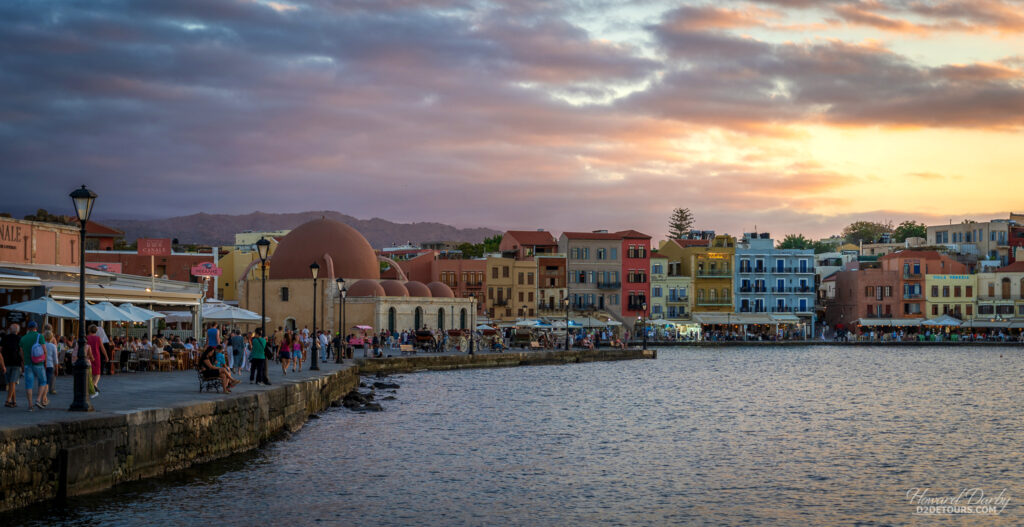
While stone tools that can be dated back 130,000 years have been found on Crete, human settlements didn’t appear until roughly 7000 BCE. The Minoan culture, known for its extensive urban planning and elaborate art, emerged around 3100 BCE, and is generally accepted as the first European civilization. The island is predominantly Mediterranean scrub with palm trees scattered sporadically along the coast. Only about one-third of the landscape can be cultivated, with most farmers working small patches of land with little to no automation. Notwithstanding those limitations, this region is one of Greece’s leading producers of olives (and olive oil), grapes, vegetables (tomatoes, potatoes, cucumbers, peppers, zucchini), and oranges. Most of the island’s population, however, are urban dwellers, residing in either Chania (Hawnya), Rethymno or Heraklion (Er-ak-lio), and tourism is the economic mainstay with the crystal-clear turquoise water lapping the shoreline one of the main draws.
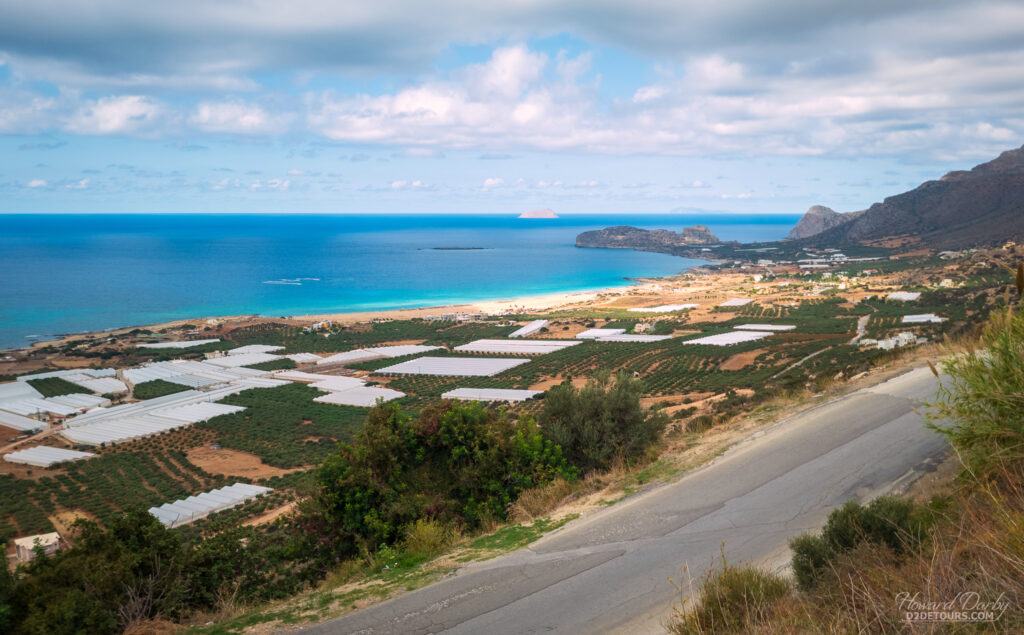
Before it became a haven for beachgoers it witnessed some rather tumultuous times. Crete was part of the Ottoman Empire between 1669 and 1898. Much of the population converted to Islam during that period, enticed by the tax and civic advantages Muslims enjoyed under the Turkish system. In reality, a vast majority of those converts were “crypto-Christians” (publicly professing to be Muslim while secretly adhering to Christianity) as evidenced by the last Ottoman census in 1881 which listed 24% of the population as Cretan Turks and 76% as Christians. Mainland Greece had been chafing under the Ottoman yoke since the mid-14th century, and began to take steps to rectify that situation in 1821. The Christian Cretan population eagerly supported the Greeks’ position, sending fighters to the mainland and staging rebellions on their home soil. The Ottomans did not appreciate their enthusiasm and retribution was often brutal. By the end of the Greek War of Independence in 1929, nearly 21% of the Cretan Christian population had perished. Alas, for a variety of complex political reasons, Crete was not included in the newly established Greek nation. Undeterred, the Cretans continued to rebel against the Ottomans, winning small concessions over the next several decades, and steadily moving towards their ultimate goal – unification with Greece.
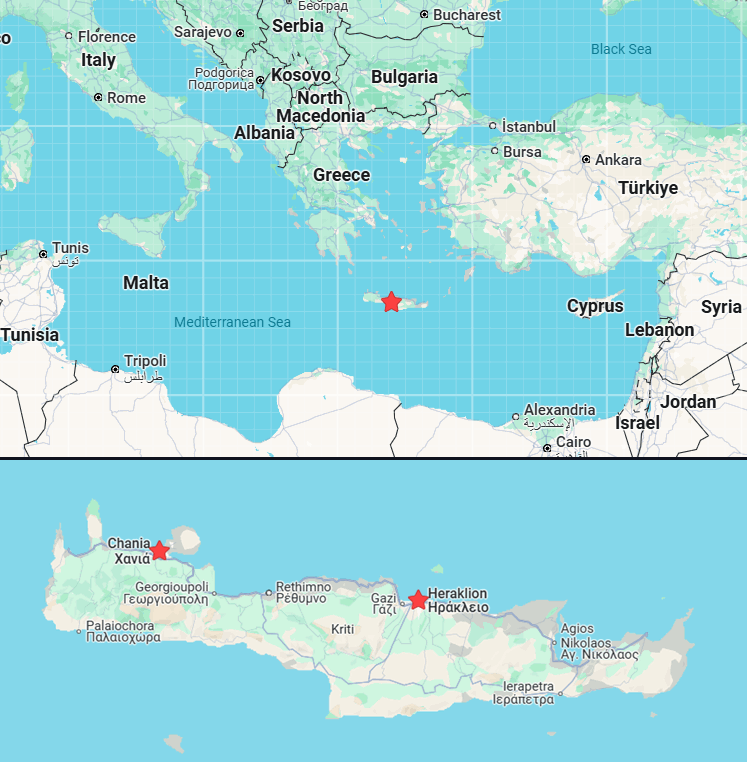
These uprisings were not taking place in a vacuum, and often it was an intervention by the international community that put the hostilities on pause. Finally, in 1897 when yet another Cretan insurrection was beginning, the Ottoman Empire declared war on Greece. That action prompted Britain, France, Italy and Russia to conclude that the Turks had lost all semblance of control, and a multi-national force was dispatched to clean up the mess. It took nearly two years, but in December 1898 a compromise was reached. An autonomous Cretan state was established within the Ottoman Empire, with Prince George of Greece named governor. Not everyone involved in the governance of this new autonomous state had the same vision for Crete’s future, and the next ten years were marked by frequent political infighting. In 1908, the Christian majority took advantage of the increasing turmoil within the crumbling Ottoman Empire, and the resulting lack of oversight, by unilaterally declaring it was joining Greece. That declaration came as somewhat of a surprise to Greece who had not been previously consulted. Despite Crete continually asserting their union with Greece, the international community, Greece included, did not formally recognize that claim until 1913 when the beleaguered Ottoman Empire decisively lost a seven month war with the Balkan League (Bulgaria, Serbia, Greece and Montenegro), resulting in some territorial adjustments. Greece formally accepted Crete.
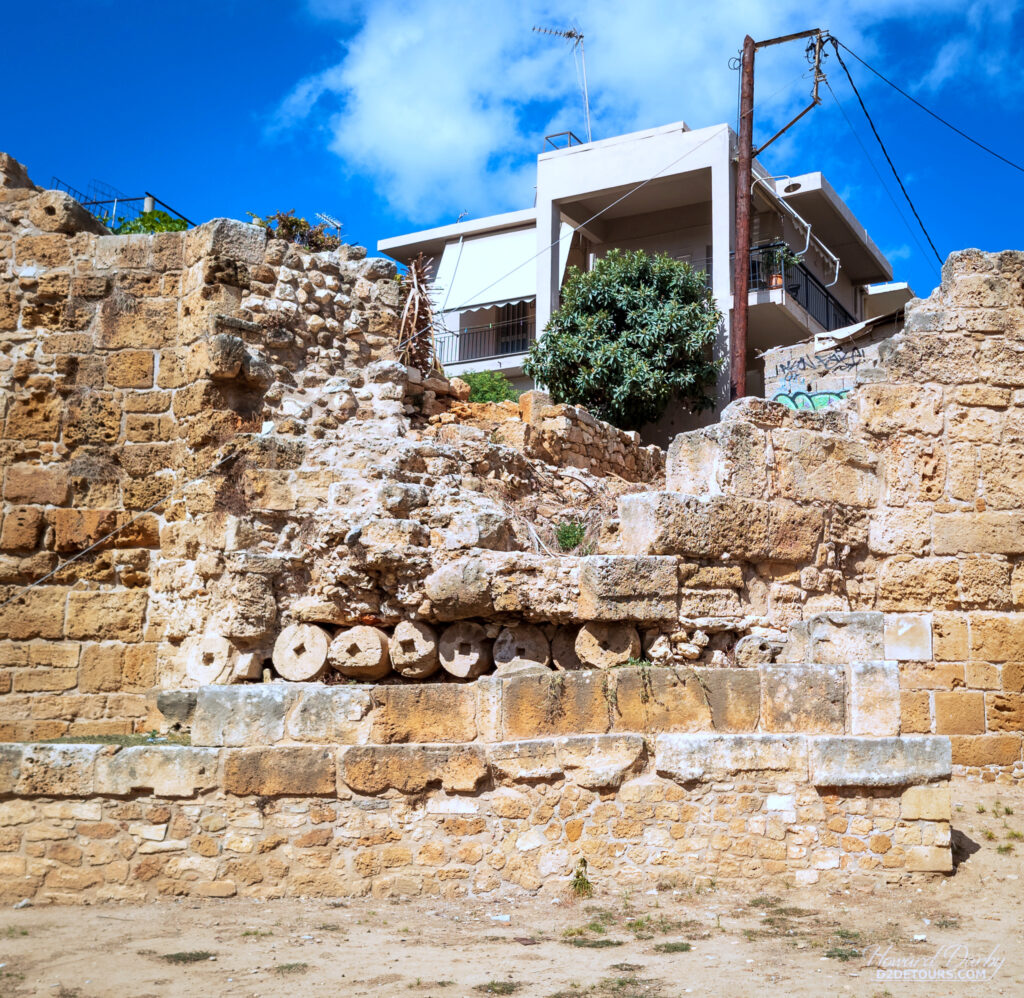
Dollars – Crete was not particularly budget-friendly – good thing we’d built up a bit of a surplus after spending seven weeks in Georgia.
| Cost/Day (2 people/10 nights) |
What’s Included? | |
|---|---|---|
| Basic living expenses | $148/day Canadian ($107 USD / €99) |
Accommodation, sightseeing, groceries, restaurants, and local transportation (including a car rental) |
| All-inclusive nomadic expenses | $187/day Canadian ($136 USD / €126) |
Basic day-to-day expenses plus: airfare from Cyprus to Crete, haircut for Whitney; data packages, subscriptions (Netflix and other streaming services, website hosting, Adobe Lightroom, VPN, misc apps, etc.), and health insurance |

Environment – We landed in Chania (pronounced Hawnya) on the northwest coast of Crete and spent seven nights in a lovely Airbnb in the hills overlooking the old Venetian Harbor.
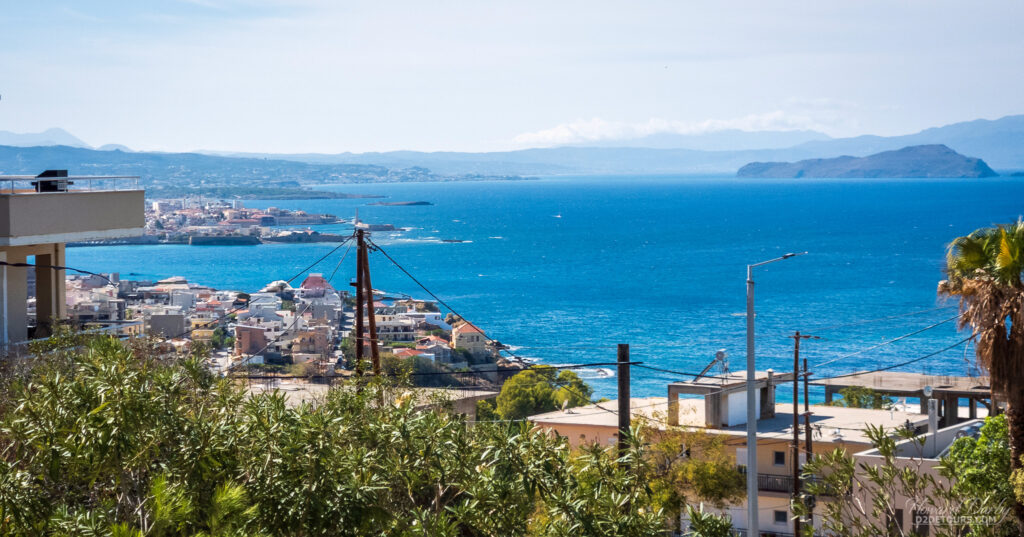
We rented a car for these seven days which meant we didn’t need to be within reasonable walking distance of anything and could find a place away from the hustle and bustle of the city center. Our hostess was lovely (the Airbnb was part of her home) and by way of apologizing for the noise from some renovation work being done upstairs, she brought us several gold “rodi” (pomegranates) from her yard. I didn’t realize there were different varieties of pomegranate and the pink arils inside these were bursting with a delicate sweet juice – very tasty.
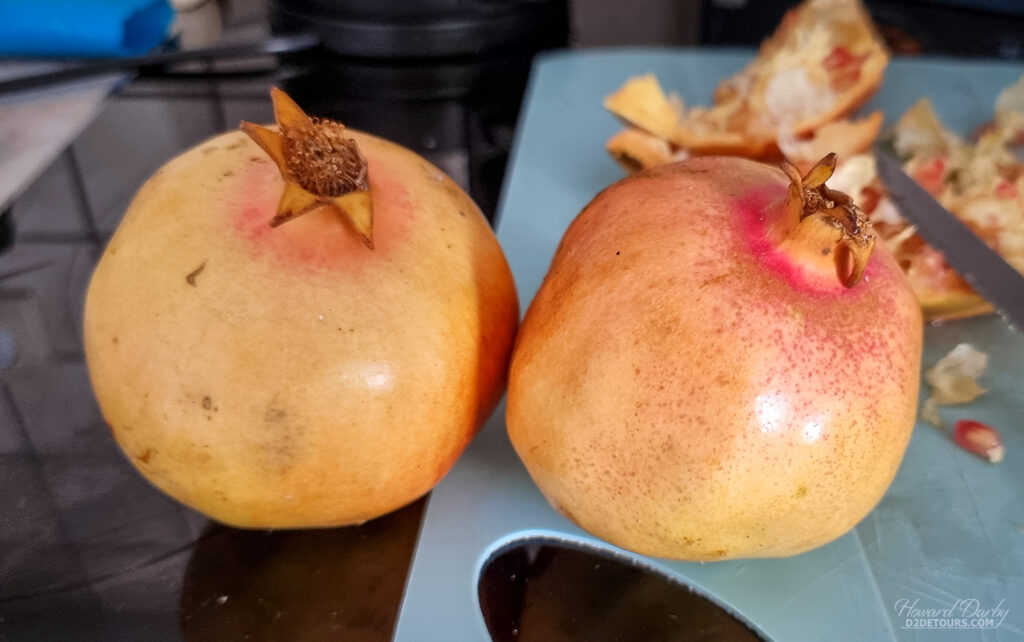
Our flight out from Crete left from Heraklion (pronounced Er-ak-lio) in the center of the island. Other than the Palace of Knossos, Heraklion didn’t hold a lot of interest for us so we only spent three nights there and opted for an Airbnb close to the city’s archeological museum and the bus to the Palace. That choice put us right in the hub of tourist activity, and it’s probably not a good sign when your host provides complimentary earplugs! Once we figured out there were actually three parts to the windows, including an outer sliding window that was not readily apparent from the interior, we were able to effectively block the street noise and slept very well without the need for earplugs.
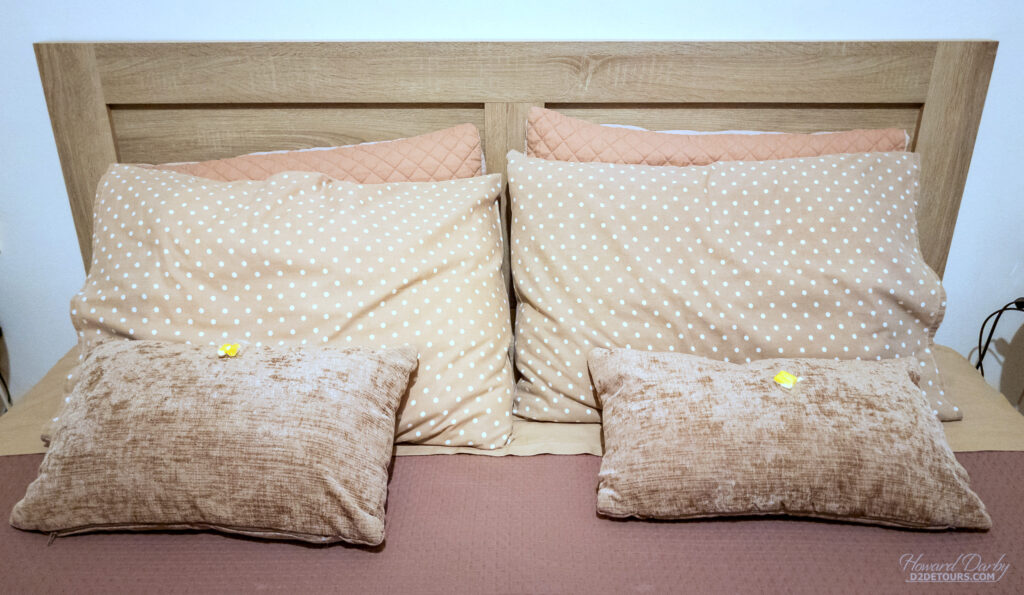
Tips, Tricks & Transportation – We rented a car for our seven days in Chania, and as we did in Georgia we rented through Localrent.com. Unlike Georgia, we got a brand new vehicle, a Suzuki Ignis, the ideal size for negotiating narrow streets or finding parking spaces. There are lots of roundabouts (traffic circles) on Crete and unless it is otherwise posted (we did see some yield and stop signs), cars ENTERING the roundabout have the right of way, which is the opposite of almost everywhere else we’ve driven! Drivers were very courteous, and the accepted practice on the single-lane highway system seems to be to hug the line between the generous shoulder and your lane of traffic to create a mutually agreed upon center lane for passing.
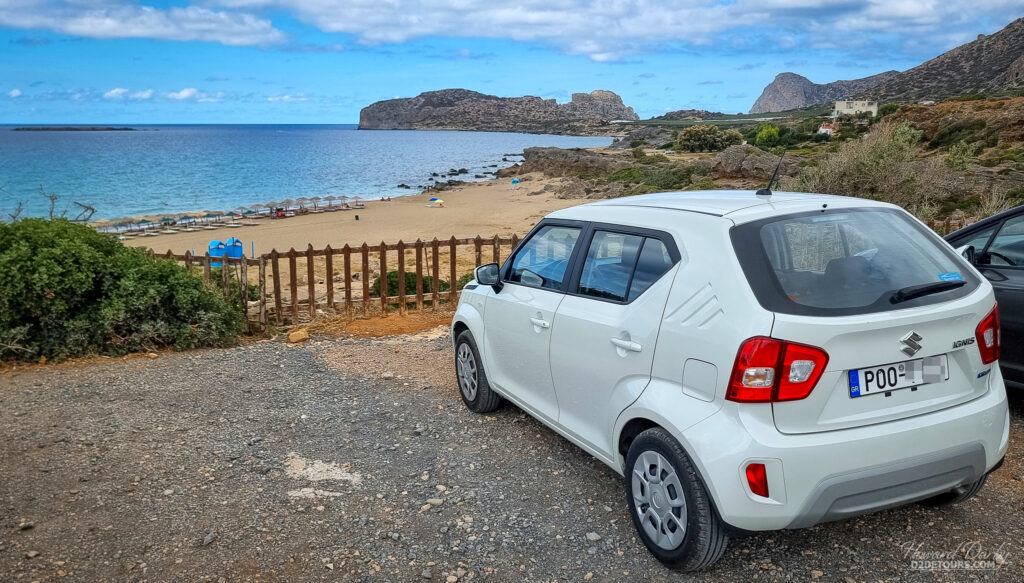
We took the bus from Chania to Heraklion and had read all sorts of complaints about ticketing and luggage constraints. We booked our tickets online ahead of time, and despite being an e-ticket, it boldly stated that the ticket must be printed out, which is a pain in the neck when you’re traveling and have to find a printer! Online reviews indicated people without printed tickets were given the evil eye when boarding but not denied boarding – we opted to risk the evil eye. The bigger concern was the apparent rule that all bags (excluding purses) must be stored in the luggage hold, no exceptions. Our backpacks have laptops, kindles, and camera equipment, and the risk of a backpack getting crushed by a large heavy suitcase seemed dangerously likely. We carefully rejigged a few things, like nestling laptops between clothing in our suitcases, and figured I could pretend Howard’s camera bag was my purse. Nobody batted an eye at our e-tickets nor could they have cared less that we boarded with our backpacks; friends we met up with had been forced to relinquish their packs the week prior when they took the same bus route … weird.
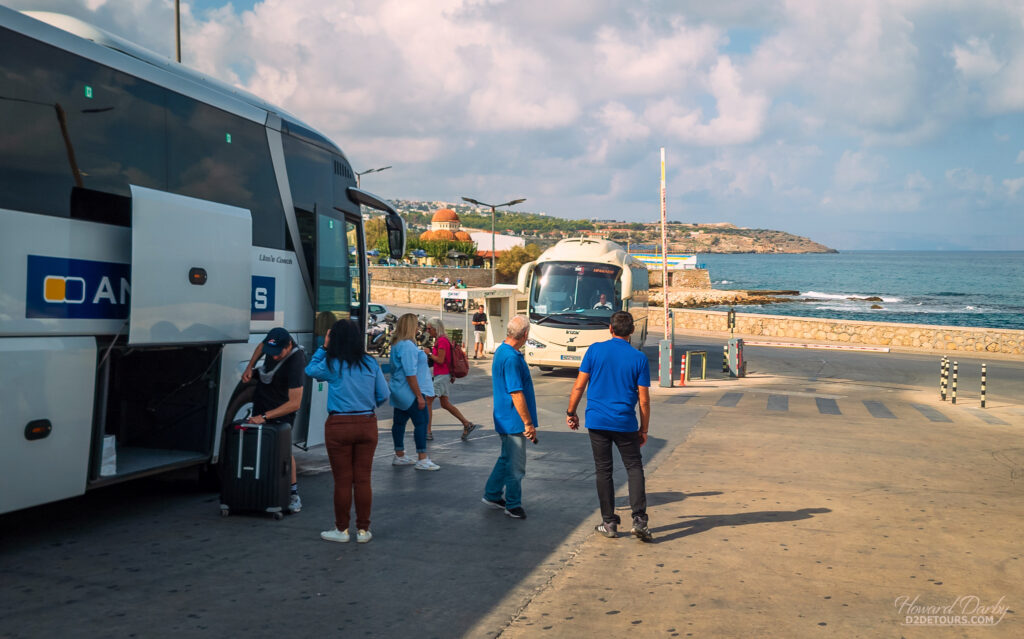
Out and About
About 26 km / 16 miles west of Chania is the olive tree of Vouves (near the village of Ano Vouves). While the scientific community has not yet settled on a universally accepted method for dating olive trees, the Vouves tree is generally considered to be the oldest of its kind still producing olives, with age estimates anywhere between 2,000 and 4,000 years. The perimeter of the trunk is 12.5 m / 41 ft and its diameter is 4.6 m / 15 ft. The wreaths placed on winning athletes’ heads during the 2004 Athens and the 2008 Beijing Olympics were woven with branches from this ancient shrub.

It is such a treat to make new friends on the road. Through Facebook we connected with fellow globetrotters who originally hailed from Maui. We spent a marvelous day together hiking in the morning and walking amongst some ancient ruins in the afternoon.

A little over an hour’s drive southeast of Chania (near Rethymno) is the Mili Gorge – a lush 5 km / 3-mile hike that follows the Mili stream as it wends its way down through a ravine. The stream is fed through a combination of natural springs and runoff from the slopes of Mount Vrysinas, and at one time provided water for the village of Mili and the 30-odd stone mills operating along its banks. Due to landslide concerns, the area was abandoned in 1972 leaving behind the crumbling remains of houses, churches, and mills. The hike is not a loop, and we wisely chose to start at the north trailhead, near the Cantina Banana, which is at the base of the gorge.
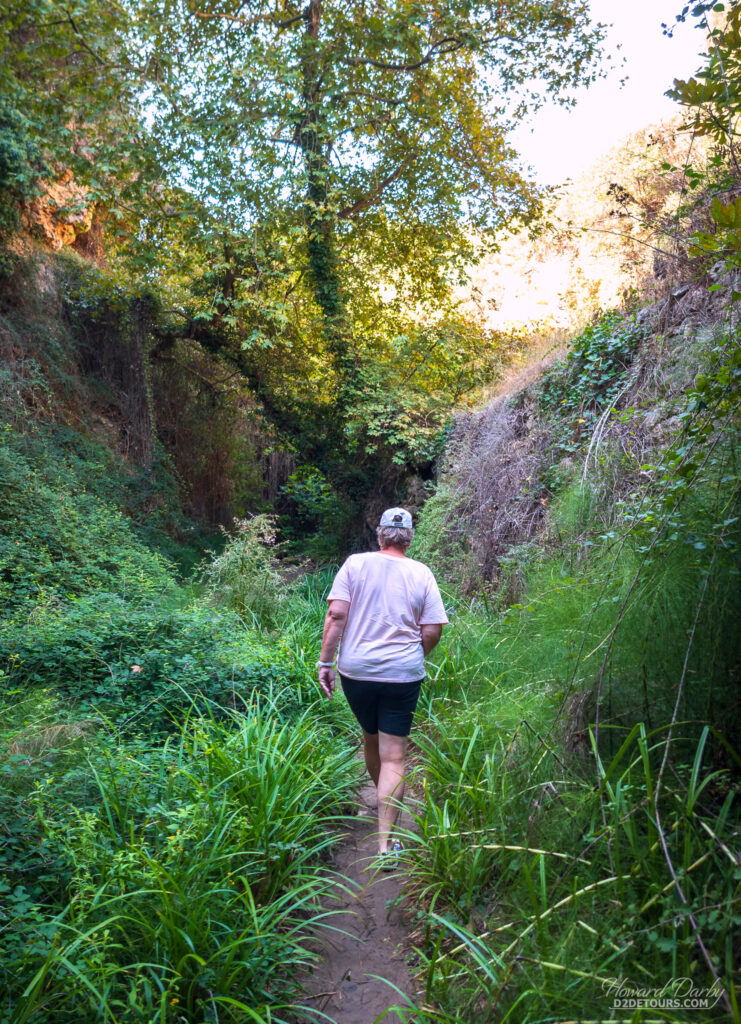


About 13 km / 8 miles east of Chania, on a plateau rising 200 m / 656 ft above Souda Bay, are the ancient remains of Aptera. Minoans, Greeks, and Romans have all occupied the site, with each successive culture building on the bones of the last – the Roman-era triple cistern was incredible. The city isn’t just rich in human history, its origin story is found in Greek mythology. The literal translation of Aptera is “without wing” and it was from this plateau that the Sirens (humanlike winged creatures with bewitching voices) lost their battle with the Muses (goddesses of literature, science, and the arts). Defeated, the Sirens forfeited their feathers and flung themselves into the sea where they would use their voices to lure sailors to their deaths.
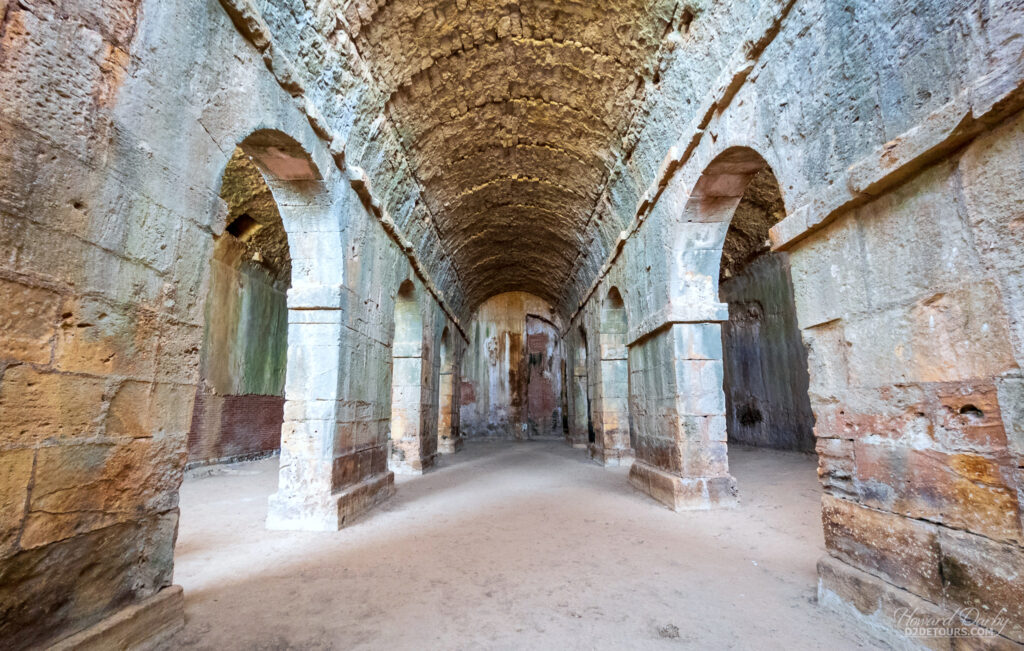
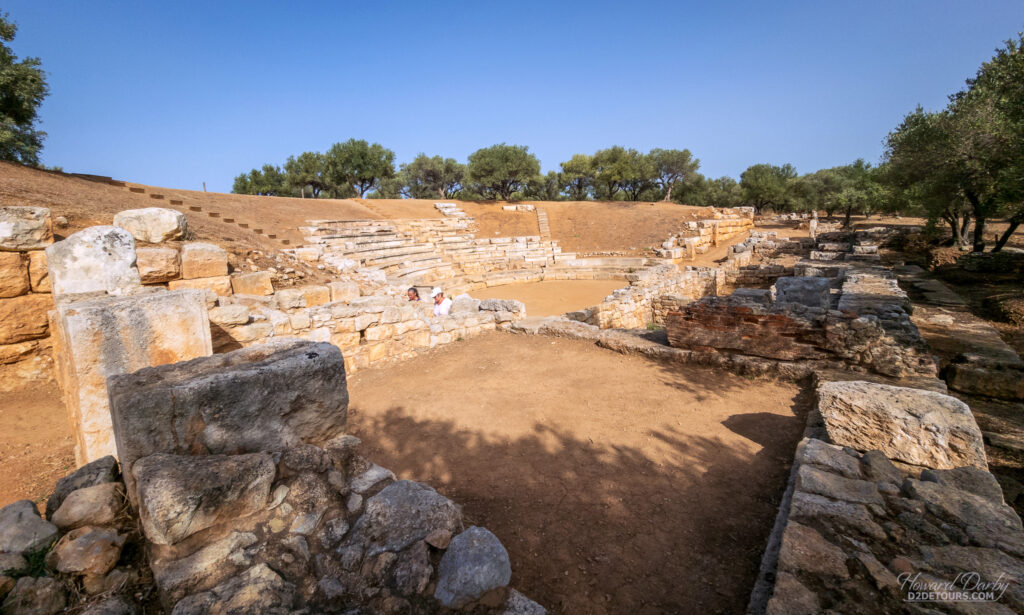
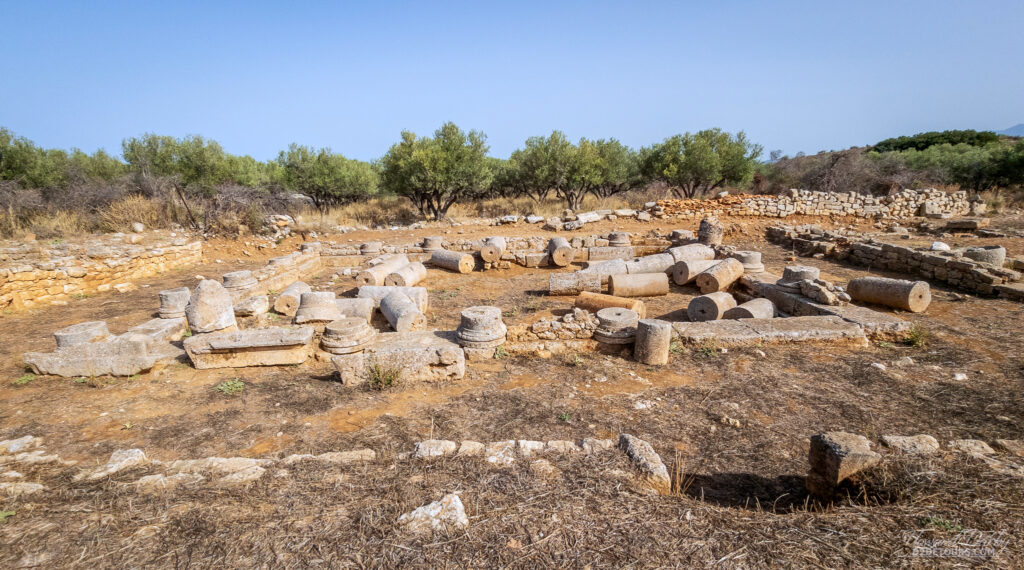
In 1205, the Republic of Venice established a colony on the island of Crete – their first major overseas outpost. Despite the difficulty in controlling a territory so far from their capital (it took nearly a month for a galley to sail from Venice to Crete), the Venetians would hold the island for nearly 465 years, until the Ottomans proved to be the more powerful empire. Fortifications were a key component to the Venetian’s longevity, and the harbours in both Chania and Heraklion boast striking examples. Construction of the Chania harbour began in 1320, and it was designed to accommodate up to 40 galleys at a time. The Firkas Fortress and the shipyards date from the mid-16th century, as does the original lighthouse, although what stands today is a 19th-century reconstruction mimicking a minaret.
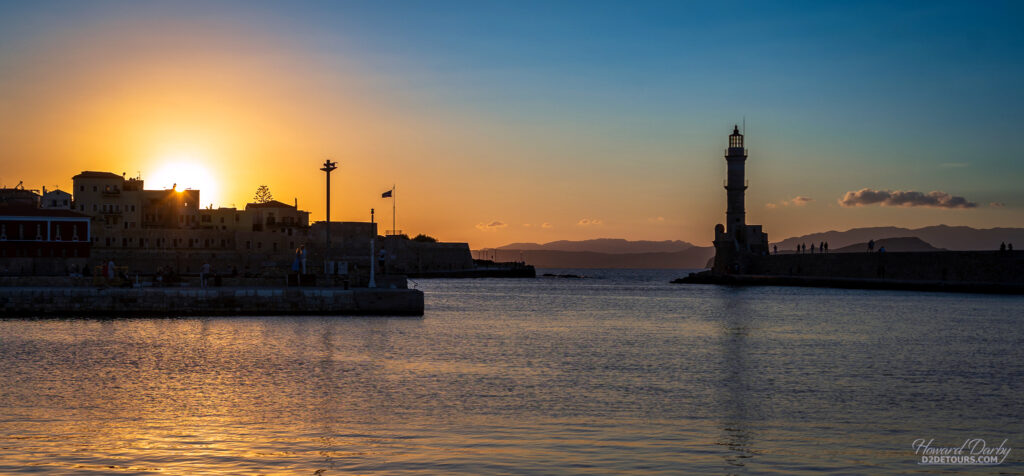

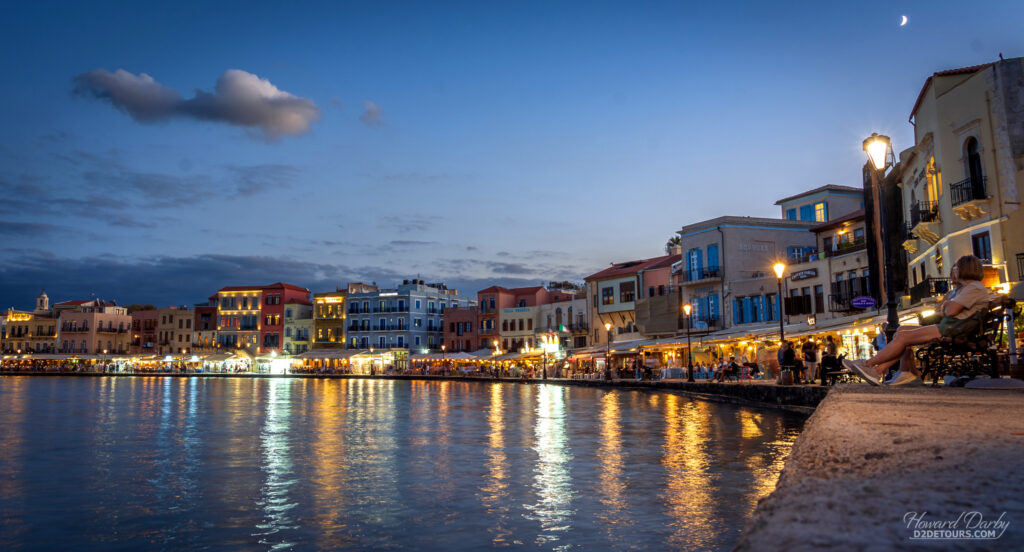
Leading away from the habour are the winding streets and alleys of the old town. most of which are lined with restaurants, pubs, and shops, yet still made for a pleasant way to while away an afternoon.
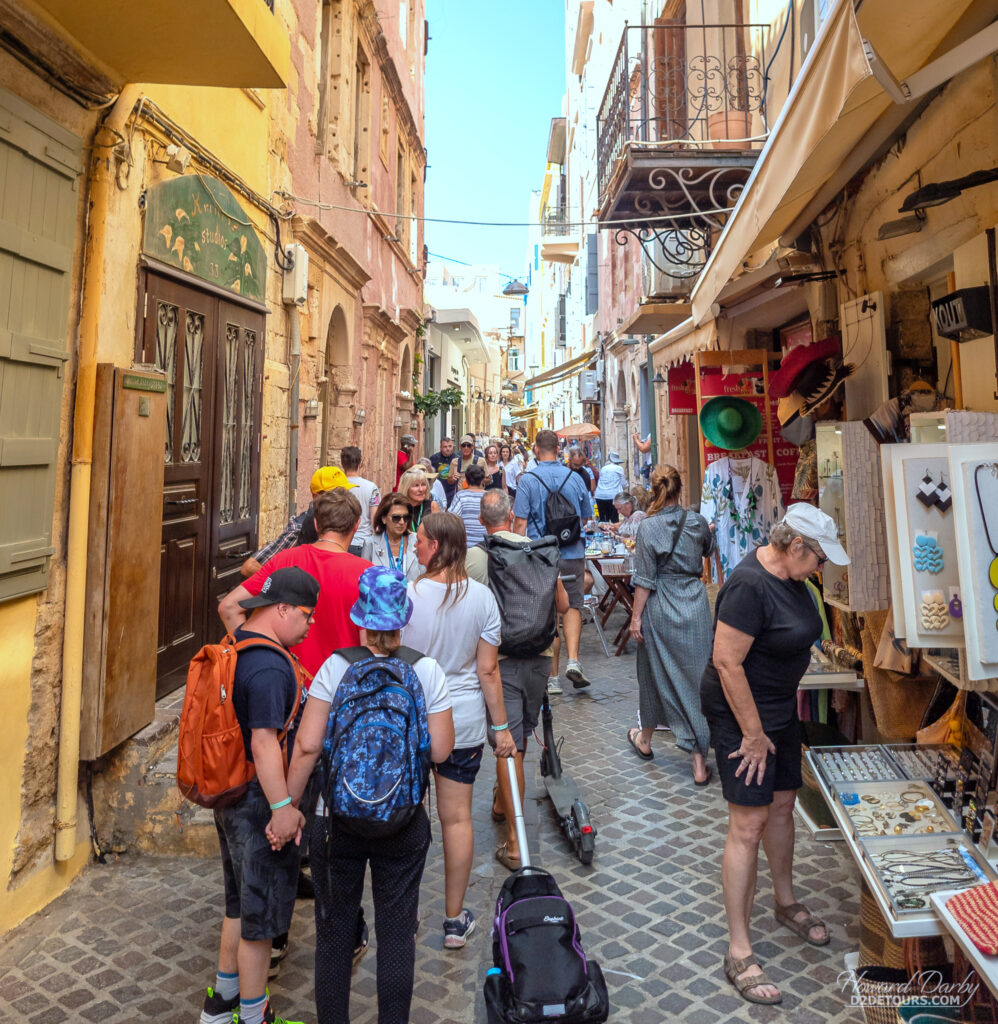
The Venetian harbour in Heraklion dates from the 16th and 17th centuries, though much has changed since then due to natural disasters and human progress. The sturdy Rocca a Mare (fort by the sea) still stands, and marks the beginning of a roughly 2 km / 1.24-mile jaunt along the sea ending at the mouth of the harbour.
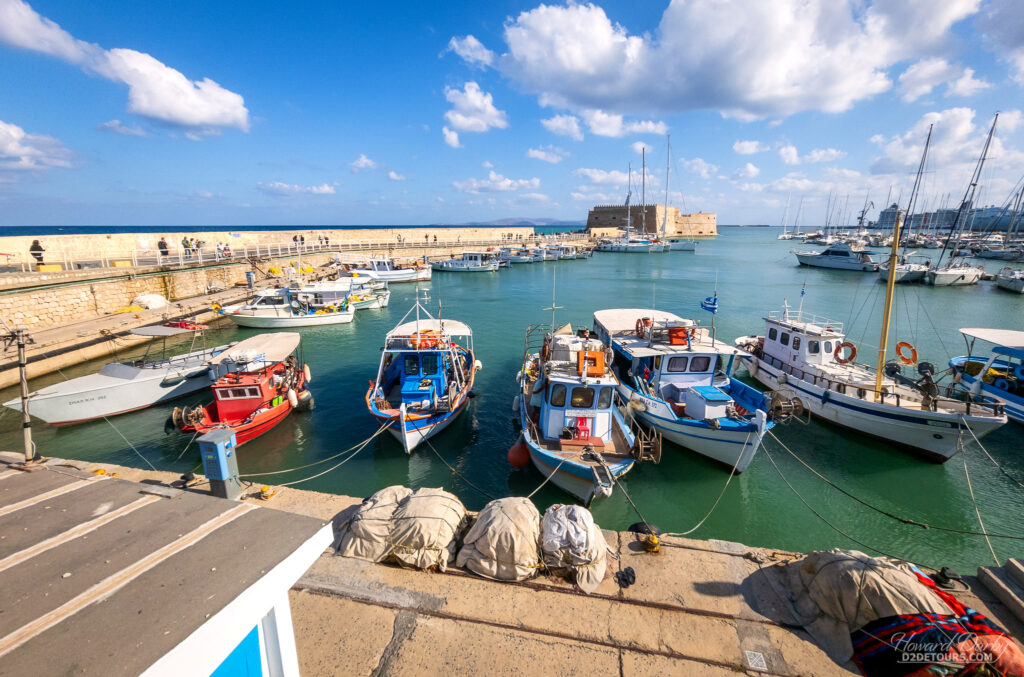
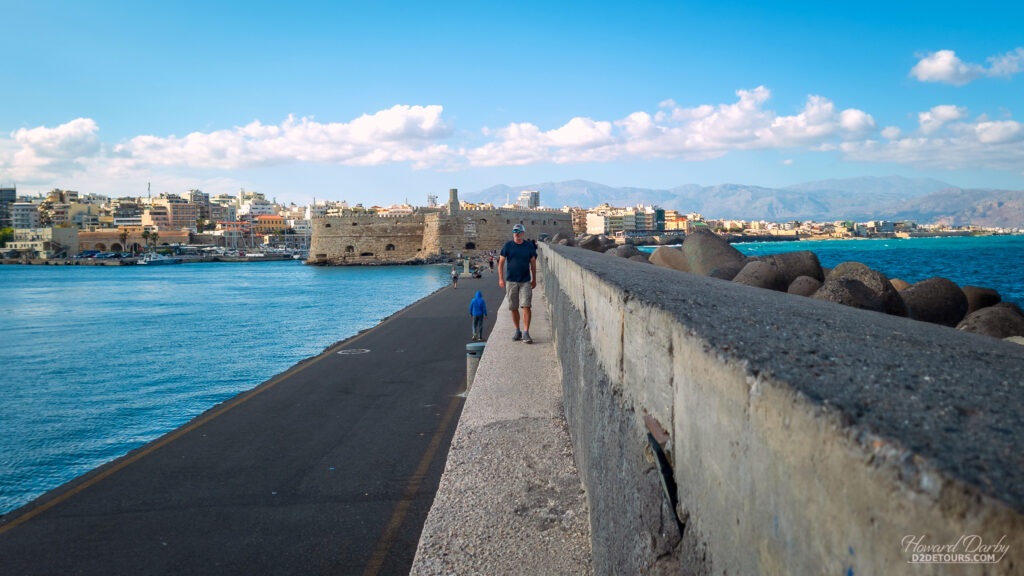
Heraklion is the capital of Crete, and didn’t exude a whole bunch of charm. However, it is the closest city to the Palace of Knossos, the largest of the five Minoan palatial structures discovered on Crete (all of which are on the tentative list of UNESCO heritage sites). “Palace” is a somewhat misleading term. These vast complexes housed a multitude of people (artisans, scribes, merchants, priests) in addition to royalty, and exemplify the shift from loosely connected nomadic communities to highly organized urban centers. Evidence of innovative water and drainage systems, the equal participation of men and women in society, and exquisite artwork have been discovered at these sites.
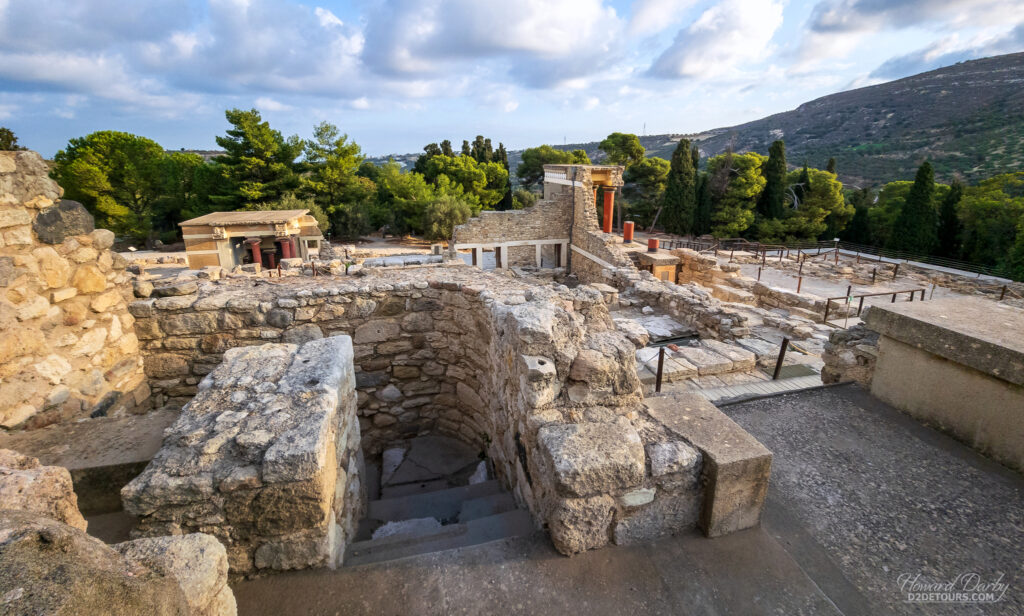
The oldest sections of the Knossos palace were built around 1900 BCE, with renovations and expansion occurring over the next five centuries. Its final footprint covered roughly eight acres before it was destroyed (likely by an earthquake) in 1350 BCE. Knossos was discovered in 1878, though only a small portion was excavated. Long-term excavation began in 1900 under the direction of British archaeologist, Sir Arthur Evans. Restoration of ancient buildings is often helpful for the average layperson to understand the structure, however, there is a fine line between restoration and reconstruction. Evans reconstructed large sections of Knossos according to his somewhat fanciful (and often incorrect) supposition as to the purpose of many of the buildings.
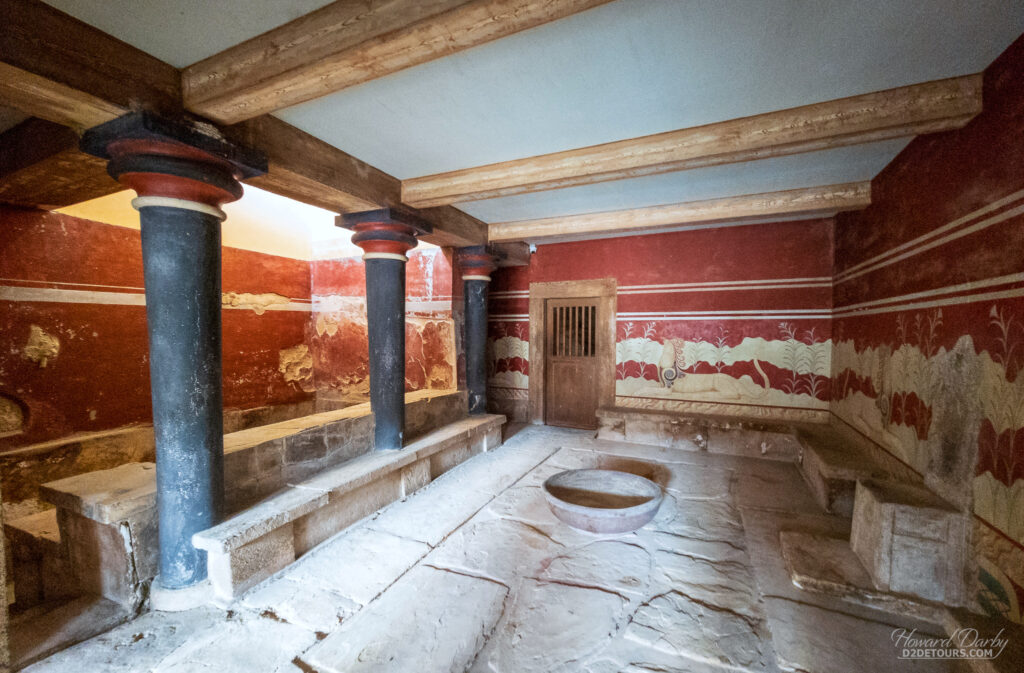
It’s understandable that bits of rubble would be open to interpretation, and as more information is unearthed archeological sites are often updated accordingly. The criticism of Evans comes from his use of concrete in his restoration, and that that work cannot be undone; he ruined the ruins.
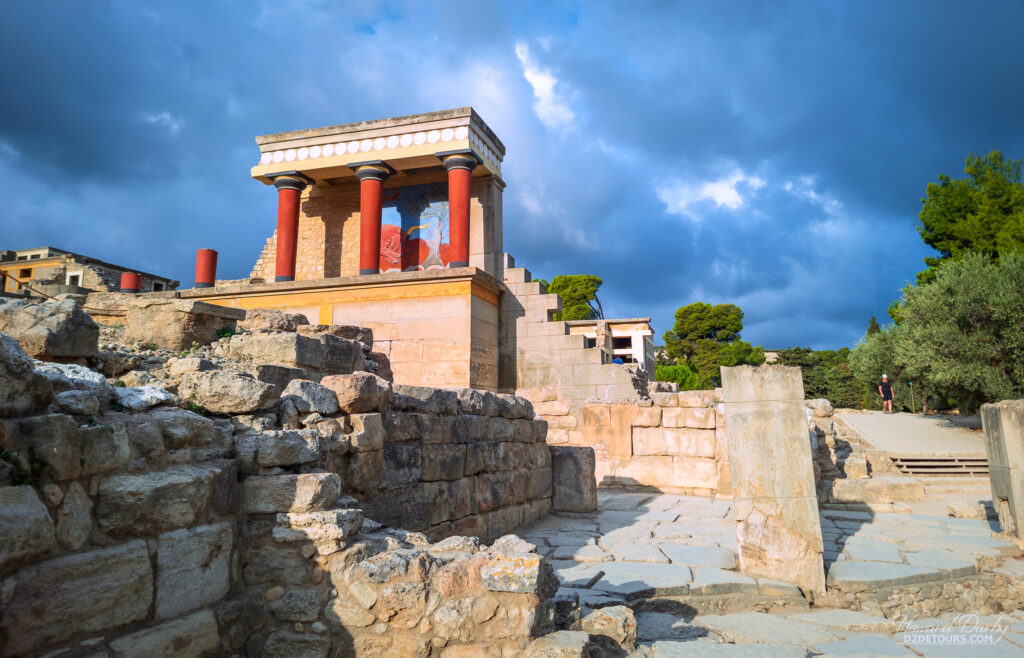
To be fair, the entire site might have collapsed into unidentifiable debris had he not undertaken his version of conservation. Still, we had mixed emotions walking past vivid red columns and frescoes entirely recreated from minuscule fragments of plaster. What is undeniable is the scale of the site, and nothing matches the feeling of staring down the length of one of the oldest roads in the world.
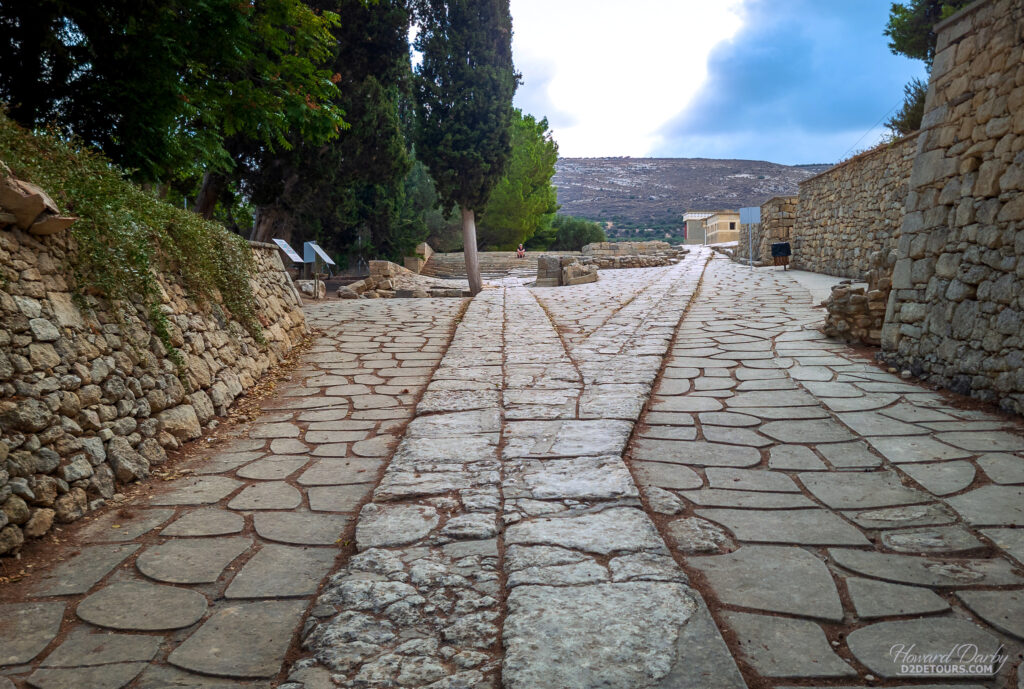
A visit to the Heraklion Archaeological Museum is an excellent companion to a tour of Knossos. The museum contains a staggering collection of Minoan artifacts, accompanied by some beautiful Greek and Roman sculptures.
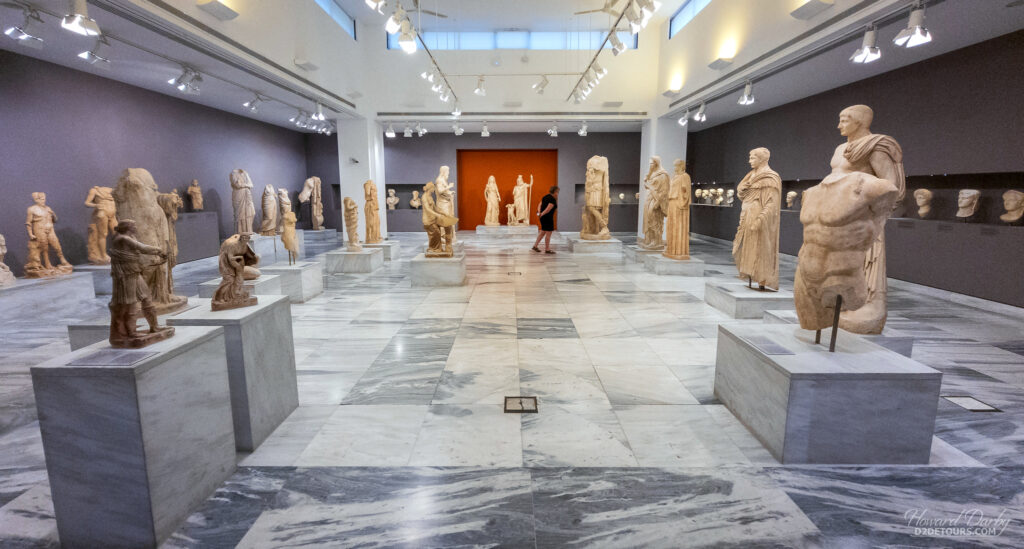
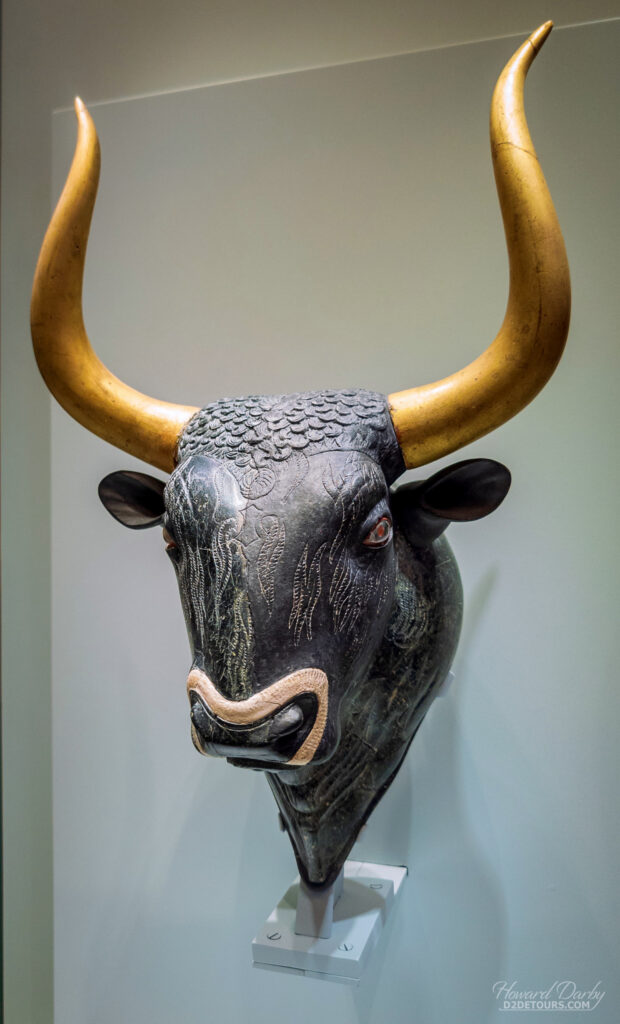
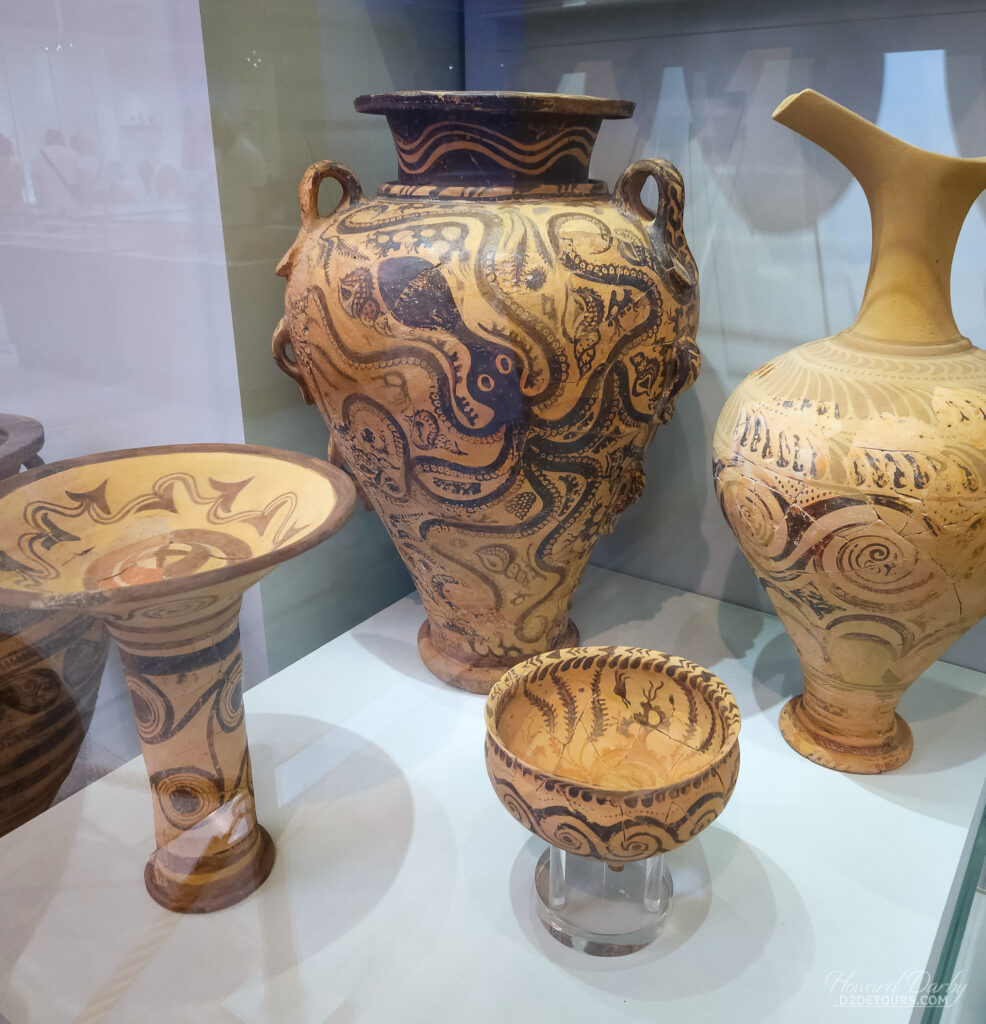
Us – We wouldn’t make a point of coming back to Heraklion, but would definitely return to Chania, not only for its charm but as a great base to explore some more of the island. All of the people with whom we interacted were incredibly gracious, and by October most of the tourists have left, fewer cruise ships are calling into port, and the temperatures are perfect: 25°-28°C / 77°-82°F! Off to Milan and Genoa, Italy!

Restaurants – We prepared most of our meals at home, but couldn’t leave the island without at least one authentic meal. The idea of stacking meat on a spit and then grilling the mound on a vertical rotisserie, slicing off meat as it cooks, was born in Bursa, Turkey. In the aftermath of WWI, and the partitioning of the Ottoman Empire, a population exchange occurred between Greece and Turkey – Greek Christians in Turkey were exchanged for Muslims living in Greece (many of whom lived on Crete). The “repatriated” Greeks brought with them their version of this rotisserie meat, the gyros (which is Greek for “turn”). A Greek gyros (in Greek gyros is a singular noun) is typically sliced pork or chicken with onions, tomatoes, lettuce, fried potatoes and tzatziki (yogurt mixed with cucumbers, garlic, olive oil, red wine vinegar, dill, mint, parsley, and thyme) rolled in a corn pita, and makes for yummy messy mouthfuls. We forgot to take a picture of our gyros but did snap a shot of the restaurant!
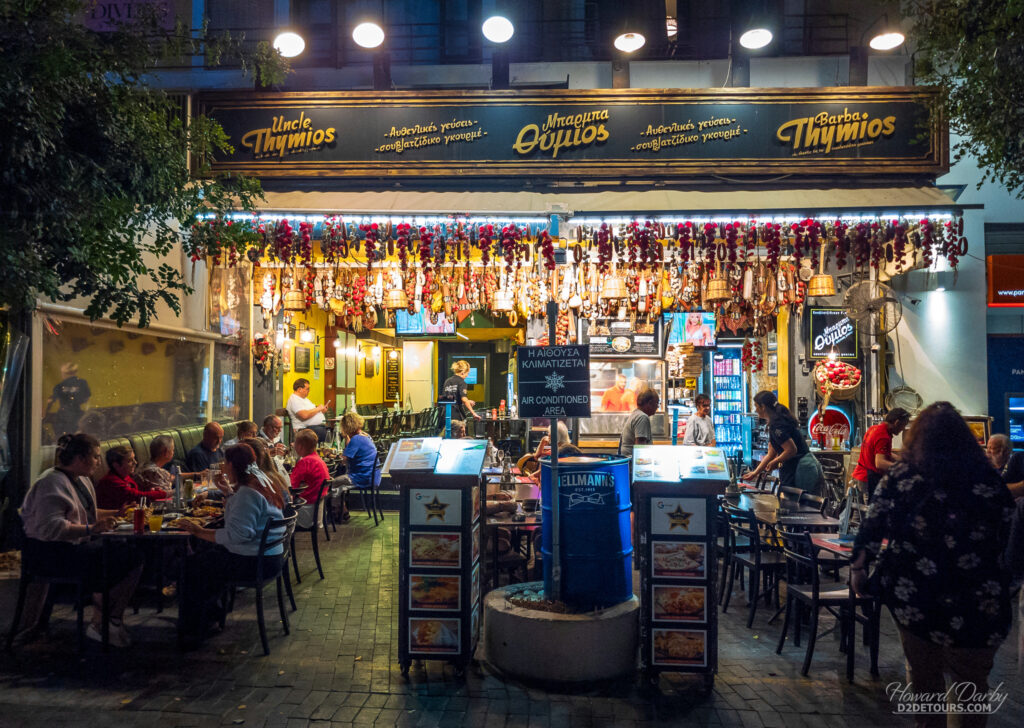
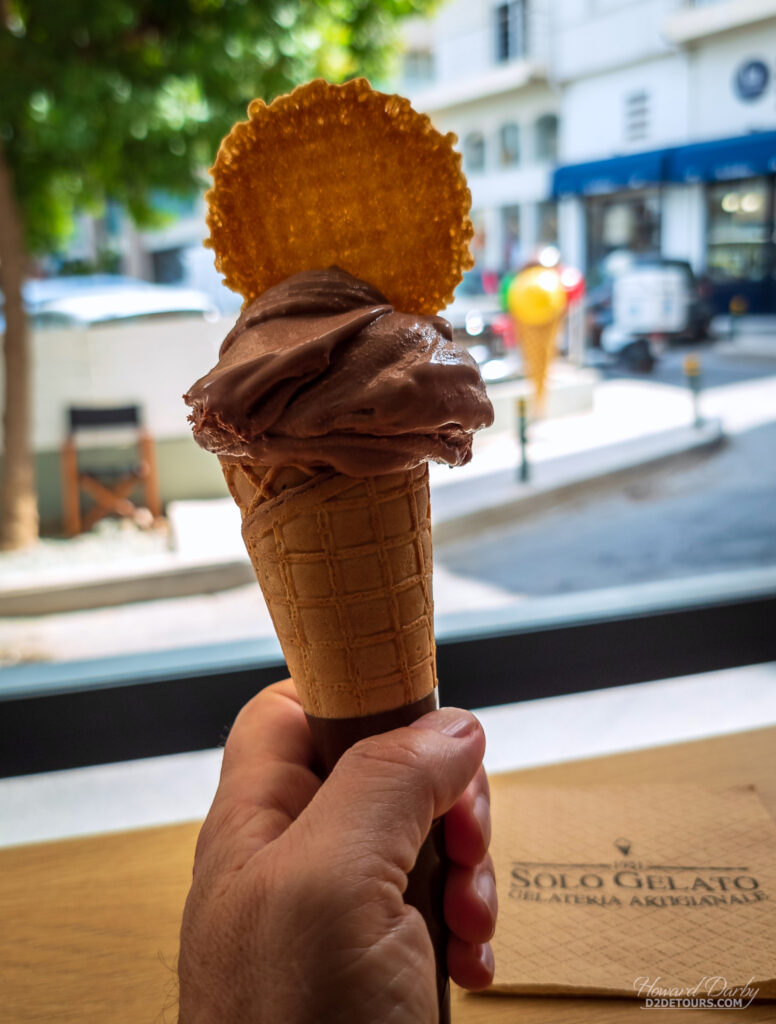
Speech – If you thought modern Greek was mystifying, its predecessor has yet to be deciphered. Between 1800 and 1450 BCE, the Minoans began keeping records using a series of lines inscribed in clay. When these tablets were discovered during excavations in the 20th century, the text was labeled Linear (lines) A to distinguish it from the pictograms found in the Cretan hieroglyphic system that, while older, was being used simultaneously on seals and clay tablets. Linear B, which first appeared in 1400 BCE, is the earliest documented form of “Greek.” It is acknowledged as having evolved from Linear A sharing as it does some of the same glyphs, but while its mysteries were unlocked in the 1950s, both Linear A and Cretan hieroglyphic texts remain unreadable.
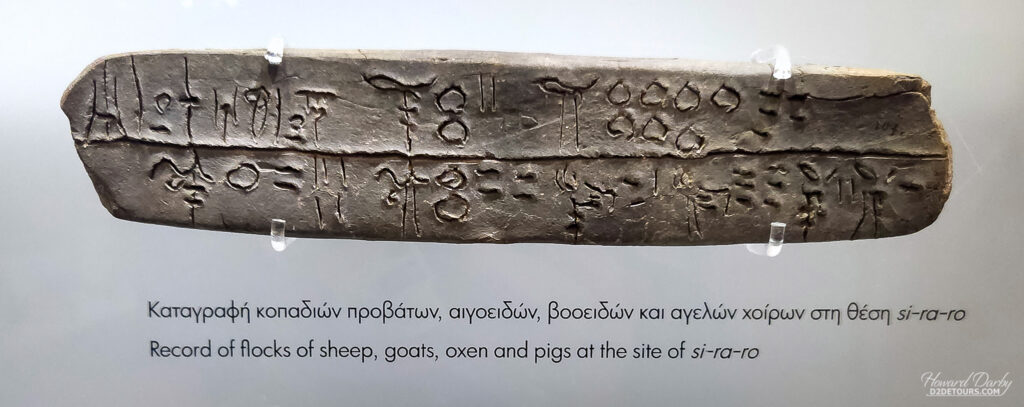
- Γεία σας (Ya sas) – Hello;
- Παρακαλώ (Parakalo) – Please, also You’re welcome;
- Eυχαριστώ (Efharisto) – Thank you;
- Όχι (Ohi) / Ναί (Ne) – Yes / No.
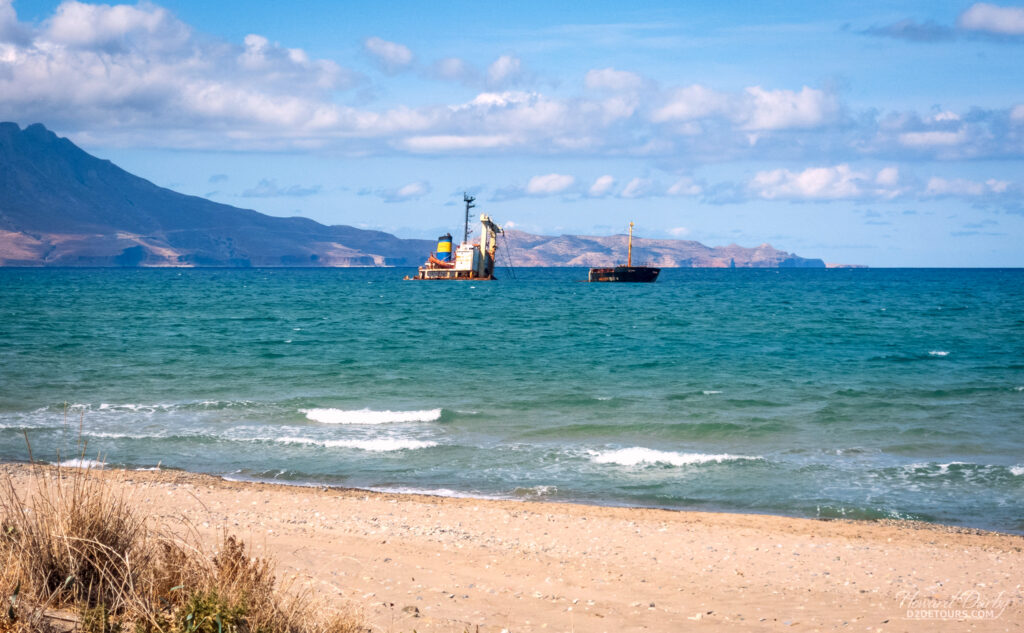

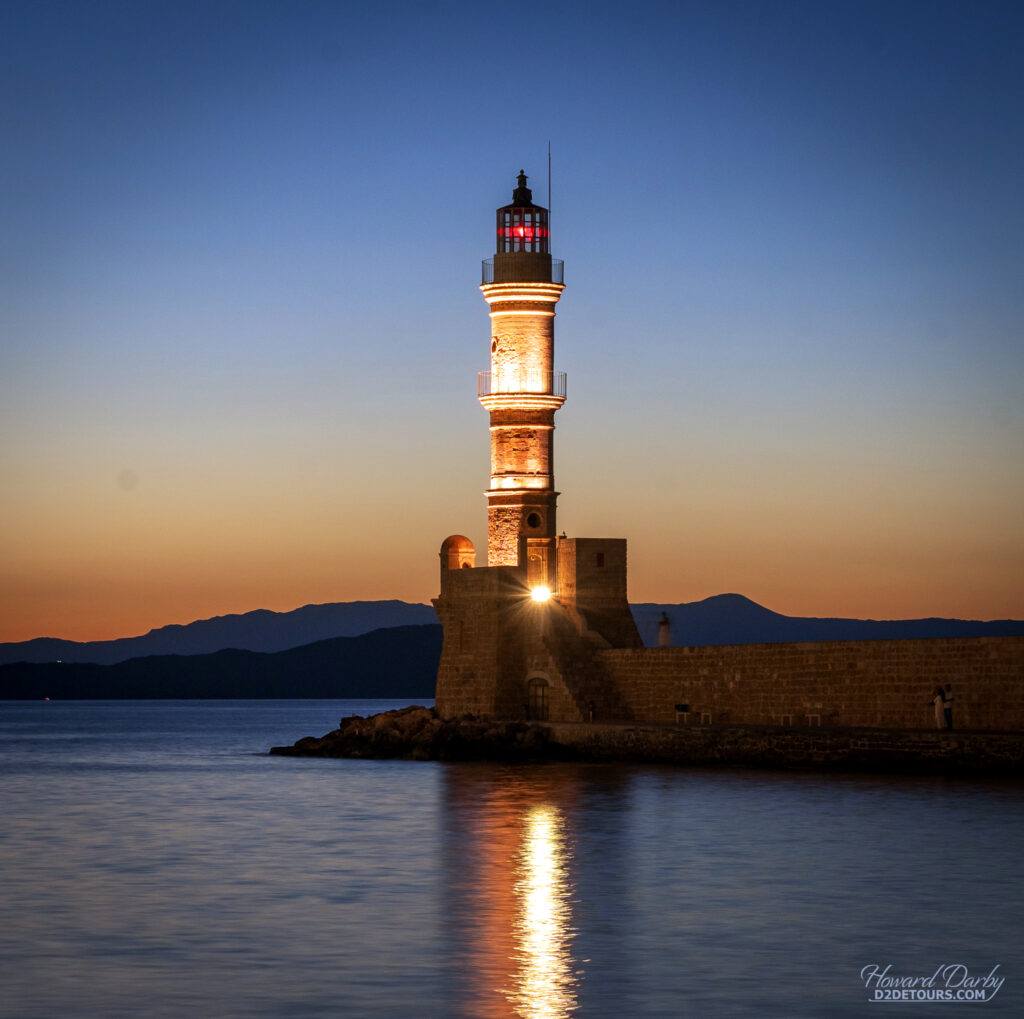

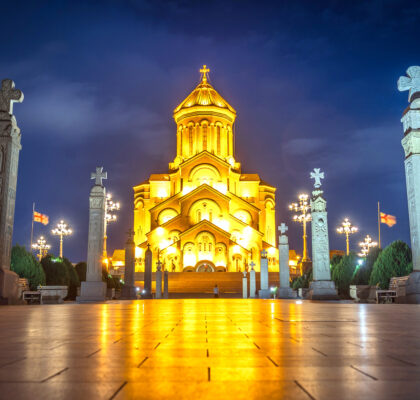
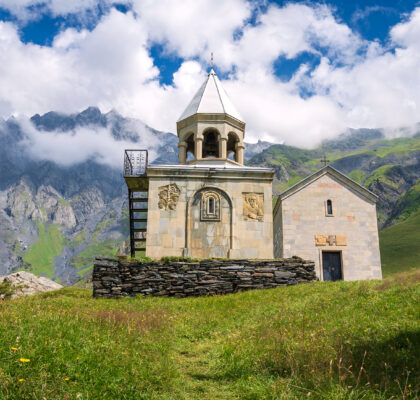
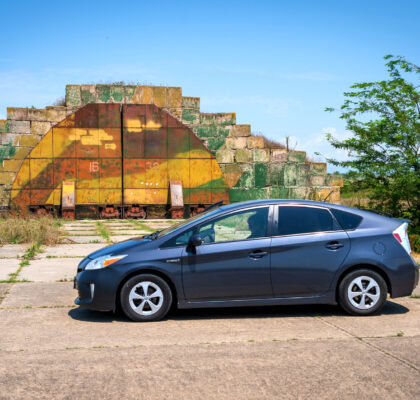
We were on Crete the last 2 weeks of April and had a similar wonderful time. I think I have told you how much I appreciate your thorough insights. Your description of Crete was a walk down memory lane. I too really appreciated the museum after the actual Palace. That replica! We are headed to Japan very soon, so your write ups have been very helpful. Anyways, I’m sure you have a list of places you want to visit. May I suggest Paros, Greece the next time you are looking at Greek Islands? lovely. Also, look up Madeira, Portugal off the coast of Turkey. It seems like a place you would enjoy and the weather is nice! I wrote about it on Senior nomads facebook page. Happy travels.
Pingback: Our Top 10 Destinations for Long Stays - D2 Detours